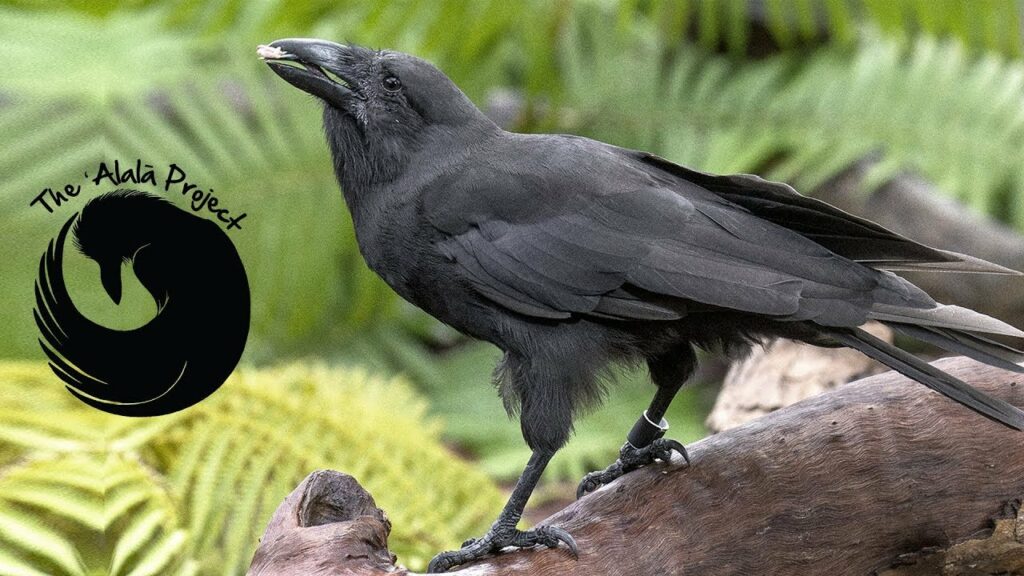If you’re visiting the Volcano Art Center on the Big Island, you may be surprised to see prints and paintings of a bird that is not commonly associated with the islands – A crow! A cousin of mainland crows, the ‘alalā (Hawaiian crow) is one of the rarest birds in the world, and is in fact endemic to Hawai’i Island.
Imagine the ancient Hawaiians stepping out of their voyaging canoes and hearing the musical call of an ink-black bird as it spread the seeds of various native forest plants. Indeed, the ‘alalā arrived in Hawaiʻi before humans first settled here, acclimating to the dry and semi-dry forests of South Kohala, Kona, Kaʻū, and our own district of Puna.
The crows’ calls led to their name, ‘alalā, which means “to bawl, bleat, cry, or squeal” in Hawaiian. Revered as sacred ʻaumākua or spiritual family guardians, the ‘alalā inspired a style of Hawaiian chanting with its vocalizations.
The Recovery Story of the ‘Alalā
Found nowhere else on the planet, the ‘alalā is the last survivor of the five native crow species that once lived in Hawai’i. Disease carried by feral cats, rats, and mongooses; habitat degradation and loss; hunting; and predation by non-native species have all threatened the ‘alalā to the point of endangerment.
In the 1970s, a handful of ‘alalā were brought into captivity after a dramatic decline in their population. A single pair of ʻalalā was last observed in South Kona in 2002, and the crow has been considered extinct in the wild ever since.
For years, the ‘alalā has lived in captivity only.
In 2016, however, a partnership between the State of Hawaiʻi Department of Land and Natural Resources, the State of Hawaiʻi Division of Forestry and Wildlife, the U.S. Fish and Wildlife Service, and San Diego Zoo Wildlife Alliance known as the ʻAlalā Project was formed to restore Hawaii’s native crow to the wild.
By 2018, the ʻAlalā Project was successful in releasing a healthy flock of ‘alalā into the wild. A year ago, however, the remaining ‘alalā had to be recaptured in response to recent mortalities and threats to their survival.
Conservationists are bringing the ‘alalā into the conservation breeding program at the Keauhou Bird Conservation Center (KBCC) for their protection, and for their assistance as well! Having successfully lived in the wild for 2 to 3 years, the recaptured ‘alalā possess knowledge about foraging, predator avoidance, and other social behaviors that may be passed on to the Hawaiian crows already in the conservation breeding program, aiding with recovery efforts.
Today, there are a sustainable number of ‘alalā ready for release, thanks to the outstanding success of the captive breeding program. The ʻAlalā Project is working on the project’s next steps and a new chapter in the recovery story of the ‘alalā, identifying and reducing threats in order to help the ‘alalā survive and thrive in the future. The ʻAlalā Project remains hopeful that we can once again see this very intelligent, vital Hawaiian birds in more than just an artist’s portal, but in their forest homes as well.
Restoring the ʻAlalā to the Wild
There is a shared ancestry among Hawaiian landscapes, people, plants, and animals, including the ‘alalā. By restoring the alalā to the wild, we are welcoming home a family member that has been away for far too long.
These birds are treasures of our island, and their return means the alalā can once again help build and restore our beautiful Hawaiian forest. There is much we can all do to help, including:
- Subscribe to the ʻAlalā Project’s monthly newsletter by clicking here.
- Become an ʻAlalā Ambassador by sharing what you’ve learned about the ‘alalā with your family and friends.
- Participate in a service-learning project at the Keauhou Bird Conservation Center (KBCC) if you are an educator. These projects typically involve an educational tour and planting of native trees to help restore a Hawaiian forest. Teachers can also get a list of resources, including activities and education programs, here.
- Advocate for the ‘alalā and other native species by contacting your government representatives.
- Visit the ʻAlalā Project’s website for more information on the ‘alalā’s release and recovery, upcoming events to support the project, and for more ways to get involved.
- Run in or volunteer for the 2021 Hawai’i Bird Conservation Marathon on Sunday, December 19, 2021.
Both the Keauhou Bird Conservation Center and the Bird Conservation Marathon’s start at the Volcano Golf Course are minutes away from our historic cottages in Volcano Village, making our vacation rentals the perfect location for those who want to experience the island while supporting Hawaii’s conservation efforts.
When you book a stay at Tutu’s Place or the Ola’a House, you’ll experience the sights and sounds of Volcano Village, Hawai’i Volcanoes National Park, and the surrounding area, and see why we’re so passionate about protecting our native plants and animals.
E Hoʻolāʻau Hou ka ʻAlalā: May the ʻAlalā thrive once again in their forest home!

